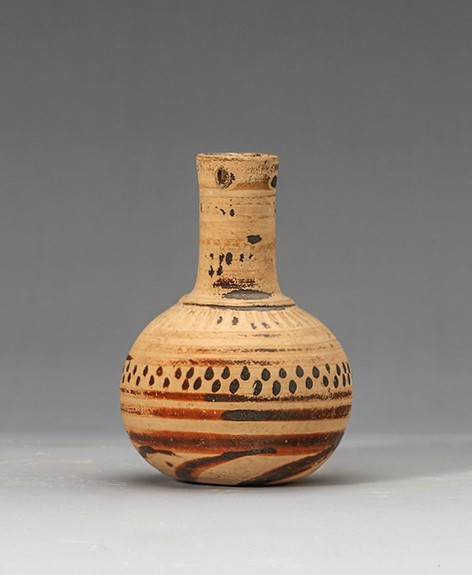Acquisition number: 1973.12
Corinthian Bottle.
Intact but much of the paint is worn. Normal Corinthian cream-buff clay. The lip is simple with suspension holes to either side of the mouth. There is a step at the base of the neck. The paint is mid- to dark-brown.
There is a broad band about the lip, three lines, then a zone of lattice with a broad band below. On the body are bars (at the shoulder), then three lines, and a dot band bounded below by three lines. There is a whirligig on the underside. There is no evidence of added colour.
Title: Corinthian Bottle - 1973.12
Acquisition number: 1973.12
Author or editor: J.R. Green
Culture or period: Middle Corinthian.
Date: Earlier 6th century BC.
Material: Clay - Terracotta
Object type: Vessels - Bottle
Dimensions: 56mm (w) × 79mm (h)
Origin region or location: Greece
Origin city: Corinth.
Display case or on loan: 3
Keywords: Greek, Middle Corinthian, Corinthian
J.R. Green with B. Rawson, Catalogue of Antiquities in the Australian National University, A.N.U., Canberra, 1981, 21.
1973.12
Corinthian Bottle
Cyril Henry Leach Bequest, by courtesy of the Trustees of the British Museum. Ht 7.9cm; diam. 5.6cm.
Intact but much of the paint is worn. Normal Corinthian cream-buff clay. The lip is simple with suspension holes to either side of the mouth. There is a step at the base of the neck. The paint is mid- to dark-brown.
There is a broad band about the lip, three lines, then a zone of lattice with a broad band below. On the body are bars (at the shoulder), then three lines, and a dot band bounded below by three lines. There is a whirligig on the underside. There is no evidence of added colour.
The bottle or round-bodied flask is a rare shape and in Greek pottery seemingly confined to Corinthian. Some figured examples are known but they generally have a more pear-shaped body (compare the well-known Timonidas bottle). The round body here is very like that of an aryballos and the latter’s influence may be seen in the decoration of the underside. For comparable examples, see Payne, Necrocorinthia 313 nos 1067-1072 and T.J. Dunbabin et al., Perachora ii (Oxford 1962) no. 2233; also the comments by R.J. Hopper, Annual of the British School at Athens (1894/5-) 44, 1949, 247ff. and for figured versions I. Jucker, Antike Kunst (1958-) 6, 1963, 47-52; also Hesperia 33, 1964, pl.19, E21-22. For a bronze vessel of this general type but set on a tripod-support found in Corfou and perhaps to be dated in the third quarter of the sixth century, see Bulletin de Correspondance Hellénique (1877-) 115, 1991, 199-206 (with useful general discussion). It is quite possible that bronze inspired the clay versions.
Probably Middle Corinthian; earlier part of the sixth century BC.
J.R. Green with B. Rawson, Catalogue of Antiquities in the Australian National University, A.N.U., Canberra, 1981, 21.
